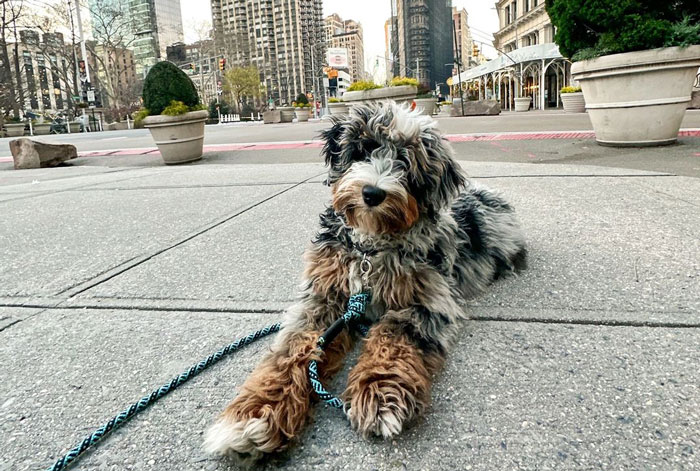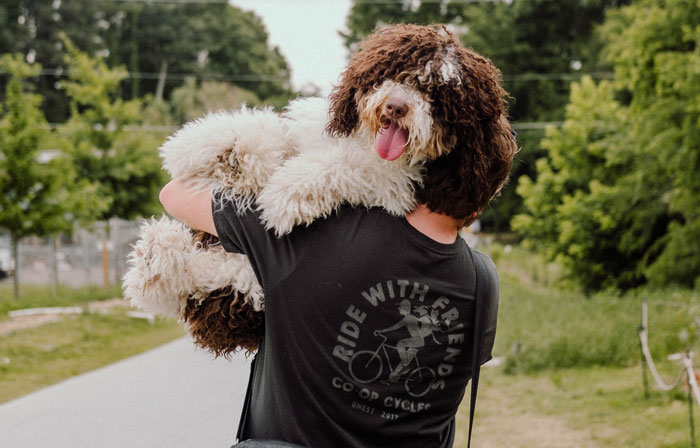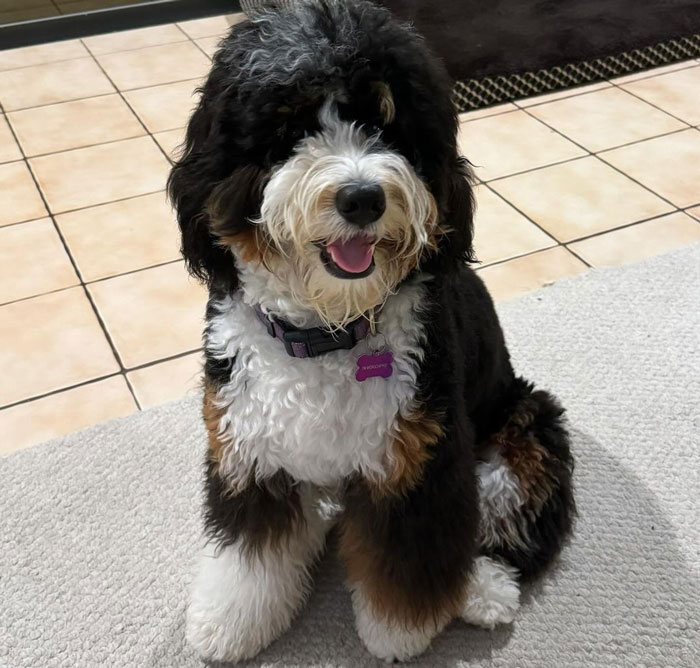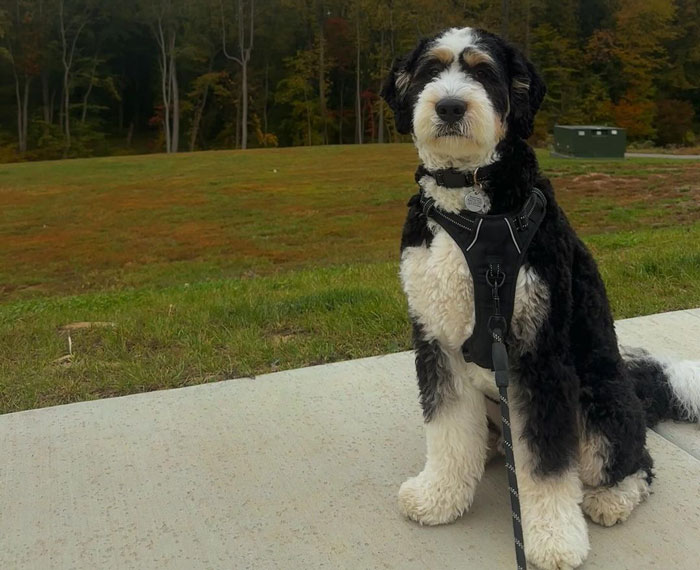The Bernedoodle is a relatively new breed that combines the intelligence of the Poodle with the affectionate nature of the Bernese Mountain Dog. If you’re thinking of getting a Bernedoodle, this article will cover all the dog breed information you need to decide if the Bernedoodle is the right fit for you and your family.
The information provided herein is for informational purposes only. Please refer to our disclaimer for more details..
Quick Facts
- Bernedoodles combine intelligence of Poodles with Bernese affection.
- They may inherit stubbornness and possible health conditions.
- Daily brushing and regular grooming are necessary for coat care.
• Breed Group: Hybrid (designer breed resulting from crossbreeding a Bernese Mountain Dog and a Poodle)
• Size: Small to large
• Lifespan: 12 to 18 years (with smaller size variations on the higher end)
• Coat: Soft, long coat that is typically wavy to curly. Shedding can vary from minimal to moderate. Multiple color variants of black, white, and brown.
• Personality: Bernedoodles are intelligent, loyal, and family-oriented but they can also be stubborn. Their energy level can vary ranging from high-energy like the Poodle to more mellow like the Bernese Mountain Dog.
• Exercise Requirement: Energy levels can vary but generally, adult Bernedoodles should get at least 30 minutes of moderate exercise daily. Caution should be used when exercising growing puppies to prevent developmental orthopedic disease.
• Training: Bernedoodles’ stubbornness can make training challenging but they are intelligent and can be encouraged with positive reinforcement. Training and socialization are necessary to help Bernedoodles become comfortable around strangers and with grooming.
• Grooming: Most Bernedoodles need to be brushed daily to prevent matting. The Bernedoodle coat type can vary which leads to variability in shedding and the need for trimming.
• Health: Bernedoodles may be predisposed to health conditions that more commonly affect their parent breeds such as hip and elbow dysplasia, eye conditions, and ear infections. Choosing a responsible Bernedoodle breeder and providing proper at-home and veterinary care are crucial in determining your Bernedoodle’s overall health and longevity.
Breed Overview
The Bernedoodle is a fairly new mixed-breed dog that combines the characteristics of the Bernese Mountain Dog and the Poodle. Bernedoodles are known for being intelligent and loving family dogs. These loyal and playful dogs make great companion dogs. Bernedoodles love attention and family time. Therefore, Bernedoodle owners need to be prepared that this type of dog will need plenty of exercise, training, and grooming. Caring for a Bernedoodle takes dedication but being a Bernedoodle parent can also be extremely rewarding and emotionally fulfilling.
Personality
It can be difficult to predict a Bernedoodle’s temperament as he may be more active and energetic like the Poodle or more laidback and chill like the Bernese Mountain Dog. Sometimes, Bernedoodles get stubborn, a trait they inherit from their Bernese Mountain Dog ancestors. But Bernedoodles are also incredibly smart, loyal, and even a little goofy.
Bernedoodles are family-oriented and love being around their owners. As a result, some Bernedoodles can become quite attached, making them prone to separation anxiety when left alone for long periods of time. Some Bernedoodles may also be wary or nervous around strangers, which is why early socialization with other people and animals is important.
A Bernedoodle’s temperament is largely reflective of its parents’ personalities. But training and socialization also play significant roles in shaping your pup’s personality.
Size
Bernedoodle size can vary quite a bit depending on what size variation of Poodle is used for breeding: the Toy Poodle, Miniature Poodle, or Standard Poodle.
Bernedoodles can come in 4 main sizes:
• Tiny: 10 to 24 pounds, 12 to 17 inches tall (measured at the level of the shoulder)
• Miniature: 25 to 49 pounds, 18 to 22 inches tall
• Medium: 50 to 70 pounds, 20 to 26 inches tall
• Standard: 70 to 90 pounds, 23 to 29 inches tall
General Care
All dog parents need to provide their pup with basic requirements like housing, food, exercise, and of course, lots of cuddles. But Bernedoodles are a unique breed of dog that requires specific care especially when it comes to exercise, training, and grooming.
Housing Recommendations
Bernedoodles can vary in size significantly. While Tiny and Miniature Bernedoodles can do well as apartment dogs, the Medium and Standard size variations of the breed may require larger housing accommodations. The main thing is that your Bernedoodle has access to larger spaces such as a backyard or dog park to meet their exercise needs.
Exercise Requirements
The exercise needs of a Bernedoodle can vary quite a bit and can be difficult to predict.
Poodles are often very intelligent and athletic. Bernedoodles may also inherit these traits, in which case he may be a dog who needs a lot more mental stimulation and physical activity. To satisfy their need to stay active and busy, many Poodles enjoy swimming, playing fetch, or going for a jog with you.
Conversely, if your Bernedoodle pulls more from his Bernese Mountain Dog roots then he may be more calm but will still need regular exercise. Bernese Mountain Dogs require at least 30 minutes of moderate exercise every day. These dogs often enjoy outdoor activities like hiking and may excel in agility, herding, and tracking.
Regardless of whether your pup is more like a Poodle or a Bernese Mountain Dog, all adult Bernedoodles should engage in about 30 minutes of moderate physical activity every day. However, when your Bernedoodle is a growing puppy, his exercise should be limited to shorter, less strenuous sessions. This is especially important if you have a Standard Bernedoodle because large breed dogs are more prone to developmental orthopedic disease.
Because Bernedoodles can have fairly thick coats, it is also important to be mindful of when you exercise your dog to avoid overheating. It is best to exercise your Bernedoodle early in the morning or in the evening when it is cooler.
Training
Bernedoodle puppies are often quite energetic so it is good to start channeling that energy into training early on. The Bernedoodle breed tends to be very smart and may try to push their boundaries with you. Therefore, it’s important to establish clear rules and expectations from the beginning.
If you have a larger Bernedoodle, it will be especially important to work on leash training to prevent them from pulling on walks. They should also be discouraged from jumping up on people since this may become problematic as they grow bigger.
Compared to other Doodle breeds, Bernedoodles can be a little more stubborn which may make training slightly more challenging. The key is to keep training sessions short and fun but consistent. Positive reinforcement is essential when you train your dog. You can reward good behavior with your Bernedoodle’s favorite toy or treats since Bernedoodles tend to be food-motivated.
A crucial part of training Bernedoodles is also teaching your dog to enjoy frequent handling, especially of their face and paws. This will make it easier when you need to groom your Bernedoodle.
Like with any dog, socialization is also an essential part of dog training. This consists of exposing your pup to a variety of sights, sounds, and smells so that he can cope with different situations without becoming stressed or anxious. Socialization is especially important for Bernedoodles since they may be apprehensive around strangers. By familiarizing your Bernedoodle with different people, places, and things, you will help him grow into a well-adjusted and confident dog.
Diet
Every dog, including Bernedoodles, needs to be fed a balanced and nutritious diet. When deciding what to feed a Bernedoodle, this means choosing a dog food that is specifically labeled for dogs of the appropriate age category.
The larger size variations of the Bernedoodle have slightly different nutritional requirements than smaller Bernedoodles. Large breeds in general are more prone to developmental bone and joint disease which can occur if the growth rate is too rapid. To prevent this, it is important not to overfeed larger dogs. Additionally, fat and calcium intake should be decreased for large-breed puppies. Therefore, larger Bernedoodles should be fed a diet specifically labeled for large-breed dogs which takes these specific nutritional requirements into account.
Bernedoodles, especially the larger size variations like Standard Bernedoodles, are also prone to bloat (aka gastric dilatation-volvulus). This is a life-threatening condition in which the stomach enlarges and twists on itself. You can help prevent this by feeding multiple smaller meals rather than fewer larger meals, avoiding elevated food bowls, and restricting exercise immediately before and after feeding.
Grooming
Bernedoodles are a mix of their parent breeds and their coat type reflects that. Bernedoodle grooming can range from low maintenance to high maintenance depending on what type of coat your Bernedoodle inherits. To understand the potential grooming needs of the Bernedoodle we must assess the coat types of the Poodle and the Bernese Mountain Dog.
If a Bernedoodle exhibits a mixture of Poodle and Bernese Mountain Dog coats, it will usually have a wavy to curly coat. However, some Bernedoodles inherit a straighter coat more reminiscent of the Bernese Mountain Dog. Bernedoodles can come in a variety of colors but the most popular variant is that which resembles the tri-colored Bernese Mountain Dog. Shedding level is quite variable since Poodles have minimal shedding whereas Bernese Mountain Dogs tend to shed a lot.
Regardless, all Bernedoodles should ideally be brushed daily to prevent mats from forming. Depending on your Bernedoodle’s coat type, she may also need intermittent trimming or clipping which can be done professionally or at home. The hair around your pup’s eyes, face, and paws should also be trimmed as needed.
All dogs, including Bernedoodles, need regular baths and nail trims. Dental hygiene is also crucial and regular toothbrushing should be a part of your dog’s grooming routine.
Regular ear cleaning is especially important for Bernedoodles because they are prone to ear infections. Your dog’s ears should be cleaned after swimming or bathing. Make a habit of inspecting your Bernedoodle’s ears weekly to check for signs of inflammation or infection.
Health
Bernedoodles are a relatively new hybrid dog and therefore, there is not extensive information about this breed’s longevity and specific health issues. If you use a reputable breeder and provide proper at-home and veterinary care, Bernedoodles tend to lead happy and healthy lives. However, like all breeds, Bernedoodles may be more susceptible to certain disease processes. When considering what type of health issues this breed might encounter, we have to look at what diseases its parent breeds are more predisposed to. The best way to avoid these health problems is to use reputable Bernedoodle breeders who are knowledgeable about health testing.
These are some health conditions to be aware of when considering Bernedoodle dog breed health:
• Hip Dysplasia: Both of the parent breeds of Bernedoodles are predisposed to hip dysplasia. Hip dysplasia is an orthopedic condition in which the hip joint develops abnormally. This results in joint instability which can produce pain and lameness. Treatment can range from surgery to physical therapy and medication. Treatment is important to minimize the development of arthritis.
• Elbow Dysplasia: Bernese Mountain Dogs can suffer from elbow dysplasia and thus, Bernedoodles can also be affected by this condition. Elbow dysplasia is the abnormal development of the elbow joint. Common symptoms of elbow dysplasia are lameness after exercise, reluctance to exercise, and pain. Although this orthopedic condition cannot be cured, it can be managed with surgery and medication.
• Patellar Luxation: Poodles, especially the smaller size variants, are predisposed to patellar luxation. This condition more commonly affects smaller breeds and therefore, smaller Bernedoodles may suffer from this condition. Patellar luxation is when one or both kneecaps are dislocated, causing the patella (aka kneecap) to slide out of place. Depending on the severity, these dogs may skip when they walk. Many of these cases are mild and may not require treatment while more severe cases may benefit from surgery.
• Bloat (aka Gastric Dilatation-Volvulus): Both Poodles and Bernese Mountain Dogs are at risk for developing bloat or gastric dilatation-volvulus. Large dogs especially with deep chests are at greater risk. Bloat is when the stomach enlarges and rotates on itself, cutting off blood supply. Talk to your veterinarian if you are interested in prophylactic surgery to help prevent this life-threatening condition.
• Progressive Retinal Atrophy: Bernese Mountain Dogs and Poodles are breeds that can be affected by progressive retinal atrophy (PRA). Thus, your Bernedoodle may also inherit PRA. PRA is a genetic eye disease that leads to blindness. Fortunately, this is not a painful condition and dogs are surprisingly good at adapting to vision loss.
• Hereditary Cataracts: Poodles are at risk for hereditary cataracts, which cause the lenses of the eyes to become abnormally opaque. Cataracts impair vision and can lead to pain and secondary issues. Therefore, surgical treatment is recommended.
• Ear Infections: Bernedoodles are more prone to ear infections because of the structure of their ears. Their floppy ear carriage and excess hair inside their ears create an environment that encourages inflammation and infection. Regularly checking and cleaning your Bernedoodle’s ears will help prevent ear infections from developing.
• von Willebrand’s Disease: Poodles and Bernese Mountain Dogs are two breeds that can be affected by von Willebrand’s Disease. von Willebrand’s Disease is an inherited bleeding disorder due to a lack of a certain protein that is necessary to control bleeding.
104views
Share on Facebook"Bernedoodle" isn't a breed. It's a mutt. A mixed-breed dog. NOT a "breed". Therefore, there is NO established, standard "temperament" or appearance that puppies/dogs of this mix will have. Even puppies in the same LITTER will differ in appearance, as they are mixed breed dogs. It's really important to keep in mind that while dogs like "Havapoos" and "Cavapoos" and "Aussiedoodles" might be adorable (and of course they are all good boys/girls) - these are NOT real "breeds". They are mutts, NOT purebreds. If someone is trying to say they are a "breeder" of one of these mixed-breeds and they charge thousands of dollars for a puppy, just keep in mind - you're buying a mutt. SO many dogs - mixed-breeds AND purebreds! - are languishing in shelters in need of a home. If you want a dog/puppy, don't spend thousands of dollars purchasing a mutt.
Bless you, my friend, this drives me crazy. I was speaking with someone this week who told me that he bought a "mini teacup bully"- the "breeder" usually sold the dogs for $3000, but he knew the person, so he only had to pay $1500. It breaks my heart to imagine the lives these dogs probably have with someone who is incredibly irresponsibly breeding bullies- especially when there are so many being euthanized, waiting for homes, in shelters.
Load More Replies...If you are going to call yourself a reporter, report the facts. There is no such breed. These are glorified mutts bred to line the pockets of backyard breeder/breeders with no regard to the health or well being of the dog.
"Bernedoodle" isn't a breed. It's a mutt. A mixed-breed dog. NOT a "breed". Therefore, there is NO established, standard "temperament" or appearance that puppies/dogs of this mix will have. Even puppies in the same LITTER will differ in appearance, as they are mixed breed dogs. It's really important to keep in mind that while dogs like "Havapoos" and "Cavapoos" and "Aussiedoodles" might be adorable (and of course they are all good boys/girls) - these are NOT real "breeds". They are mutts, NOT purebreds. If someone is trying to say they are a "breeder" of one of these mixed-breeds and they charge thousands of dollars for a puppy, just keep in mind - you're buying a mutt. SO many dogs - mixed-breeds AND purebreds! - are languishing in shelters in need of a home. If you want a dog/puppy, don't spend thousands of dollars purchasing a mutt.
Bless you, my friend, this drives me crazy. I was speaking with someone this week who told me that he bought a "mini teacup bully"- the "breeder" usually sold the dogs for $3000, but he knew the person, so he only had to pay $1500. It breaks my heart to imagine the lives these dogs probably have with someone who is incredibly irresponsibly breeding bullies- especially when there are so many being euthanized, waiting for homes, in shelters.
Load More Replies...If you are going to call yourself a reporter, report the facts. There is no such breed. These are glorified mutts bred to line the pockets of backyard breeder/breeders with no regard to the health or well being of the dog.

 Image credits:
Image credits:  Image credits:
Image credits:  Image credits:
Image credits:  Image credits:
Image credits: 












-3
3